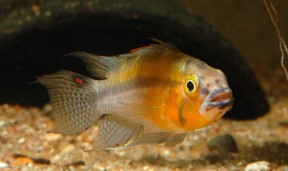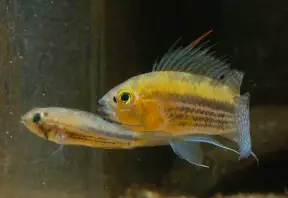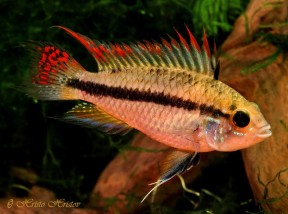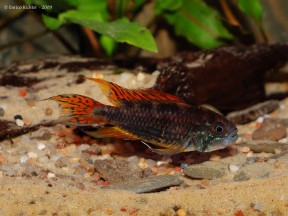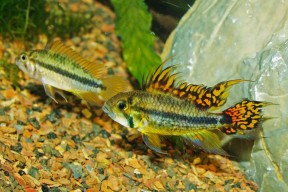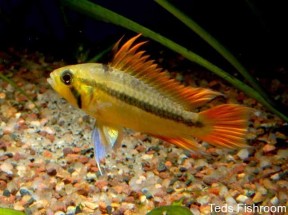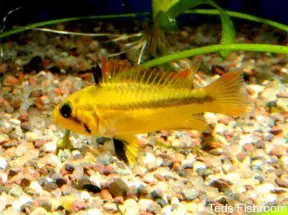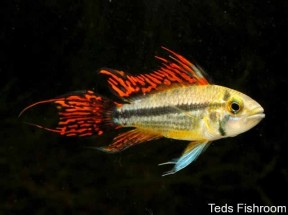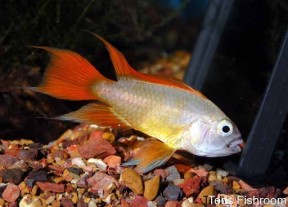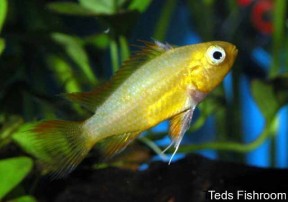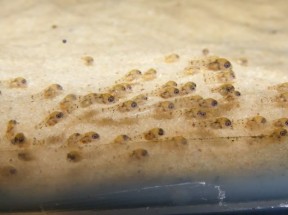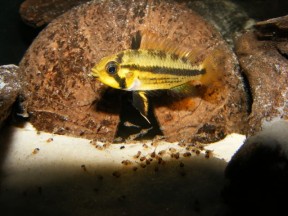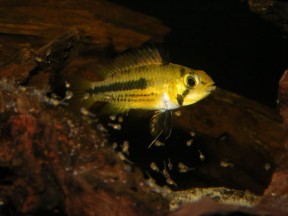Apistogramma cacatuoides
Cockatoo Cichlid
Classification
Order: Perciformes Family: Cichlidae
Distribution
The type locality was originally given incorrectly as Paramaribo, Suriname but this was later amended by Kullander to the “Amazon River basin, between 69°W and 71°W”. The species is currently considered widespread throughout much of the upper Amazon basin from the ríos Ucayali and Amazonas in Peru to the Solimões in western Brazil. Some populations exhibit notable differences in colour patterning.
Habitat
Tends to inhabit slower-moving tributaries, backwaters and creeks in areas where fallen leaf litter collects and these may contain black, white or clear water depending on locality or in some cases, time of year.
Maximum Standard Length
Aquarium SizeTop ↑
Base dimensions of 60 ∗ 30 cm or more are acceptable for a single pair with a group requiring larger quarters.
Maintenance
Provided adequate cover and structure is available this species is unfussy with regards to décor with ceramic flowerpots, lengths of plastic piping and other artificial materials all useful additions. A more natural-looking arrangement might consist of a soft, sandy substrate with wood roots and branches placed such a way that plenty of shady spots and caves are formed.
The addition of dried leaf litter (beech, oak or Ketapang almond leaves are all suitable) would further emphasise the natural feel and with it bring the growth of beneficial microbe colonies as decomposition occurs. These can provide a valuable secondary food source for fry, whilst most populations will appreciate the tannins and other chemicals released by the decaying leaves. Leaves can be left in the tank to break down fully or removed and replaced every few weeks. If maintaining a blackwater population a net bag filled with aquarium-safe peat can also be added to the filter or suspended over the edge of the tank.
Fairly dim lighting is recommended and plant species from genera such as Microsorum, Taxiphyllum, Cryptocoryne and Anubias are best since they will grow under such conditions. A few patches of floating vegetation to diffuse the light even further may also prove effective. Filtration, or at least water flow, should not be very strong and very large water changes are best avoided with 10-15% weekly adequate provided the tank is lightly-stocked.
Water Conditions
Temperature: 22 – 29 °C
pH: Commercially-produced fish are relatively unfussy but some wild populations may require values of 5.0 – 6.0 in order to breed.
Hardness: 0 – 268 ppm, again depending on origin to an extent.
Diet
Primarily carnivorous and apparently feeds mostly on benthic invertebrates in nature. In the aquarium live and frozen foods such as Artemia, Daphnia and chironomid larvae (bloodworm) should be offered regularly although most specimens will also learn to accept dried alternatives with pelleted products generally preferred to flake.
Behaviour and CompatibilityTop ↑
Captive-raised fish are the recommended choice for the general community aquarium. Wild examples are best maintained alone or with small ‘dither’ fishes such as Nannostomus spp., and ideally should not be mixed with other Apistogramma.
Sexual Dimorphism
Males are larger, more colourful and develop more extended fins than females.
Reproduction
Substrate spawner which normally lays its eggs in crevices or cavities among the décor. The female is responsible for post-spawning care of eggs and fry and in smaller aquaria the male may need to be removed as she may become hyper-aggressive.
NotesTop ↑
Numerous ornamental forms of this species have been selectively line-bred for the aquarium trade, vernacular names for which include “sunset”, “sunburst”, “double red”, “triple red”, “gold”, “white gold”, “orange flash” and “albino“. It has also been assigned the ‘A’ number A200 under the DATZ system with possibly conspecific, related forms similarly numbered A201, A202 and A203 depending on locality.
The genus Apistogramma is among the most speciose of South American ccihlid genera with around 70 species valid at present but many more awaiting description. In addition many species exist in two or more geographical colour forms which may or may not turn out to be distinct in the future. Hobbyists tend to label these with collection data if available in order to avoid mixing them and the potential of hybridisation.
Member species have also been organised into a series of species lineages, complexes and groups by authors in order to better separate them. Such lists have been augmented by fish that have appeared in the aquarium trade and are in a state of near-constant flux. The A. cacatuoides group, for example, is contained within the A. trifasciata sublineage of the larger A. trifasciata lineage alongside A. arua plus the A. brevis, A. nijsseni, A. atahualpa and A. trifasciata groups.
Kullander (1998) conducted a morphology-based phylogenetic study in which the neotropical family Cichlidae was divided into six subfamilies of which the putative subfamily Geophaginae contained 16 genera divided among three ‘tribes’:
Acarichthyini – Acarichthys and Guianacara.
Crenicaratini – Biotoecus, Crenicara, Dicrossus and Mazarunia.
Geophagini – Geophagus, Mikrogeophagus, ‘Geophagus‘ brasiliensis group, ‘Geophagus‘ steindachneri group, Gymnogeophagus, Satanoperca, Biotodoma, Apistogramma, Apistogrammoides and Taeniacara.
Later molecular studies by Farias et al. (1999, 2000, 2001) resulted in the additions of Crenicichla and Teleocichla to the Geophaginae, a result supported by López-Fernández et al. (2005) who conducted the most detailed molecular analysis of the grouping to date including 16 of the 18 genera and 30 species. However their conclusions regarding interrelationships between genera did vary somewhat from previous hypotheses and can be summarised by the following loosely-defined groups:
– a weakly-supported sister group relationship between Acarichthys and Guianacara.
– a well-supported “Satanoperca clade” comprising Satanoperca, Apistogramma, Apistogrammoides and Taeniacara.
– a “big clade” with Geophagus, Mikrogeophagus, ‘Geophagus‘ brasiliensis group, ‘Geophagus‘ steindachneri group, Gymnogeophagus, Biotodoma, Crenicara and Dicrossus.
– a “crenicarine clade” with Biotoecus and Crenicichla.
No representatives of Teleocichla or Mazarunia were included in the study but the former is well-established as sister to Crenicichla while the latter has grouped closely with Dicrossus and Crenicara in earlier works. The other main conclusions of the paper are confirmation that Geophaginae is a monophyletic group exhibiting strong signs of having undergone rapid adaptive radiation (diversification of a species or single ancestral type into several forms that are each adaptively specialised to a specific environmental niche).
References
- Kullander, S. O. 1986 - Department of Vertebrate Zoology, Research Division, Swedish Museum of Natural History, Stockholm, Sweden, 394 p.
Cichlid fishes of the Amazon River drainage of Peru. - Kullander, S. O. 2003 - Porto Alegre: EDIPUCRS, Brasil
Cichlidae (Cichlids). In R.E. Reis, S.O. Kullander and C.J. Ferraris, Jr. (eds.) Checklist of the Freshwater Fishes of South and Central America. - Römer, U. 2006 - Mergus Verlag GmBH, Melle, Germany. 1320 p.
Cichlid Atlas Volume 2.

